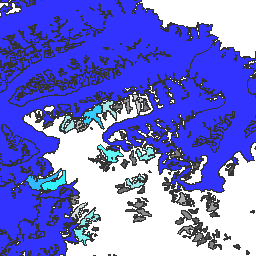
- Disponibilità del set di dati
- 1750-01-01T00:00:00Z–2023-06-07T00:00:00Z
- Fornitore di set di dati
- National Snow and Ice Data Center (NSDIC)
- Tag
Descrizione
Global Land Ice Measurements from Space (GLIMS) è un'iniziativa internazionale con l'obiettivo di rilevare ripetutamente i circa 200.000 ghiacciai del mondo.
Il progetto mira a creare un inventario completo a livello globale del ghiaccio terrestre, incluse misurazioni di area, geometria, velocità superficiale e altitudine della linea di neve dei ghiacciai. Per eseguire queste analisi, il progetto GLIMS utilizza dati satellitari, principalmente dell'Advanced Spaceborne Thermal Emission and Reflection Radiometer (ASTER) e del Landsat Enhanced Thematic Mapper Plus (ETM+), nonché informazioni storiche derivate da mappe e fotografie aeree.
Ogni funzionalità di questo set di dati è un confine poligonale di un ghiacciaio al momento dell'analisi. Alcuni ID ghiacciaio hanno centinaia di righe distinte nel tempo.
Questo set di dati è un'istantanea dell'inventario dei confini dei ghiacciai al 7 giugno 2023 e fornisce oltre 1.100.000 righe.
Schema della tabella
Schema della tabella
| Nome | Tipo | Descrizione |
|---|---|---|
| analisti | STRING | Nome o nomi dei collaboratori data clean room |
| anlys_id | DOUBLE | ID di un ghiacciaio in un determinato momento |
| anlys_time | STRING | Quando è stata eseguita l'analisi |
| area | DOUBLE | Area del ghiacciaio nel piano della proiezione della mappa in chilometri quadrati |
| chief_affl | STRING | Affiliazione del responsabile del centro regionale |
| db_area | DOUBLE | Come "area", ma ricalcolato dal progetto GLIMS |
| geog_area | STRING | Nome della regione geografica coperta dal centro regionale |
| glac_id | STRING | L'ID ghiacciaio GLIMS |
| glac_name | STRING | Il nome del ghiacciaio. Circa l'80% delle righe è uguale a "Nessuno" |
| glac_stat | STRING | Stato di Glacier, "exists" (esiste) o "None" (nessuno) |
| lunghezza | DOUBLE | Lunghezza del perimetro del ghiacciaio in metri |
| line_type | STRING | Tipo di record del ghiacciaio, ad es. "glac_bound" per i ghiacciai, o altri valori per rocce interne, nevai, elementi idrici, ecc. |
| local_id | STRING | ID assegnato dall'istituto che ha contribuito o dal centro regionale |
| max_elev | DOUBLE | La parte più alta del ghiacciaio, in metri sopra il livello del mare |
| mean_elev | DOUBLE | Elevazione media del ghiacciaio, in metri sopra il livello del mare |
| min_elev | DOUBLE | La parte più bassa del ghiacciaio, in metri sopra il livello del mare |
| parent_id | STRING | ID del ghiacciaio principale di questo ghiacciaio |
| primeclass | DOUBLE | Numero di classificazione del ghiacciaio WGMS |
| proc_desc | STRING | Descrizione del trattamento eseguito su questo record |
| rc_id | DOUBLE | ID utilizzato dal centro regionale |
| rec_status | STRING | Stato record |
| release_dt | STRING | Data di pubblicazione dei dati, nel formato AAAA-MM-GGTHH:mm:ss |
| src_date | STRING | Data delle immagini di origine utilizzate per creare il contorno |
| subm_id | DOUBLE | L'ID invio assegnato da GLIMS |
| mittenti | STRING | Nome o nomi dei richiedenti dei dati |
| wgms_id | STRING | ID del World Glacier Monitoring Service |
| larghezza | DOUBLE | Larghezza del ghiacciaio in metri |
Termini e condizioni d'uso
Termini e condizioni d'uso
Per la creazione di report, pubblicazioni, nuovi set di dati, prodotti derivati o servizi risultanti dal set di dati, gli utenti devono citare: GLIMS e NSIDC (2005, aggiornato nel 2013): Global Land Ice Measurements from Space glacier database. Compilato e reso disponibile dalla comunità internazionale GLIMS e dal National Snow and Ice Data Center, Boulder CO, USA, doi:10.7265/N5V98602
DOI
Esplorare con Earth Engine
Editor di codice (JavaScript)
var dataset = ee.FeatureCollection('GLIMS/current'); var visParams = { palette: ['gray', 'cyan', 'blue'], min: 0.0, max: 10.0, opacity: 0.8, }; var image = ee.Image().float().paint(dataset, 'area'); Map.setCenter(-35.618, 66.743, 7); Map.addLayer(image, visParams, 'GLIMS/current'); Map.addLayer(dataset, null, 'for Inspector', false);
Visualizzare come FeatureView
Un FeatureView è una rappresentazione accelerata e di sola visualizzazione di un
FeatureCollection. Per ulteriori dettagli, visita la
documentazione di FeatureView.
Editor di codice (JavaScript)
var fvLayer = ui.Map.FeatureViewLayer('GLIMS/current_FeatureView'); var visParams = { color: { property: 'area', mode: 'linear', palette: ['gray', 'cyan', 'blue'], min: 0.0, max: 10.0 }, opacity: 0.8, polygonStrokeOpacity: 0 }; fvLayer.setVisParams(visParams); fvLayer.setName('GLIMS/current'); Map.setCenter(-35.618, 66.743, 7); Map.add(fvLayer);
